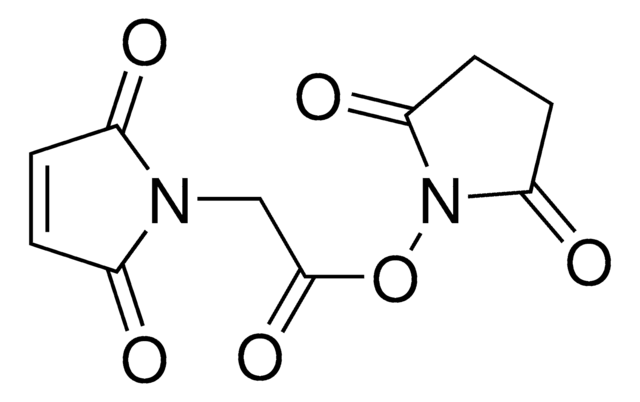803618
DTME (dithio-bis-maleimidoethane)
別名:
1,1′-(dithiodi-2,1-ethanediyl)bis-1H-Pyrrole-2,5-dione, 1-[2-[[2-(2,5-Dihydro-2,5-dioxo-1H-pyrrol-1-yl)ethyl]dithio]ethyl]-1H-pyrrole-2,5-dione, DTME
About This Item
おすすめの製品
アッセイ
≥90%
フォーム
powder
分子量
312.37
反応適合性
reagent type: cross-linking reagent
保管条件
desiccated
溶解性
DMSO or DMF: soluble
輸送温度
ambient
保管温度
2-8°C
SMILES記法
O=C(C=CC1=O)N1CCSSCCN2C(C=CC2=O)=O
InChI
1S/C12H12N2O4S2/c15-9-1-2-10(16)13(9)5-7-19-20-8-6-14-11(17)3-4-12(14)18/h1-4H,5-8H2
InChI Key
SGVWDRVQIYUSRA-UHFFFAOYSA-N
詳細
特徴および利点
- Reactive groups: maleimide (both ends)
- Reactive towards: sulfhydryl groups
- Long (13.3A), cleavable, sulfhydryl-to-sulfhydryl crosslinker, composed of maleimide groups and 11-atom disulfide spacer arm
- Water-insoluble—dissolve first in DMF or DMSO, then add to aqueous reaction buffers
- Cleavable by reduction of disulfide spacer arm with DTT, TCEP or other reducing agent
注意
シグナルワード
Warning
危険有害性の分類
Acute Tox. 4 Dermal - Acute Tox. 4 Inhalation - Acute Tox. 4 Oral - Eye Irrit. 2 - Skin Irrit. 2 - STOT SE 3
ターゲットの組織
Respiratory system
保管分類コード
11 - Combustible Solids
WGK
WGK 3
引火点(°F)
Not applicable
引火点(℃)
Not applicable
適用法令
試験研究用途を考慮した関連法令を主に挙げております。化学物質以外については、一部の情報のみ提供しています。 製品を安全かつ合法的に使用することは、使用者の義務です。最新情報により修正される場合があります。WEBの反映には時間を要することがあるため、適宜SDSをご参照ください。
Jan Code
803618-50MG:
最新バージョンのいずれかを選択してください:
この製品を見ている人はこちらもチェック
アクティブなフィルタ
ライフサイエンス、有機合成、材料科学、クロマトグラフィー、分析など、あらゆる分野の研究に経験のあるメンバーがおります。.
製品に関するお問い合わせはこちら(テクニカルサービス)










